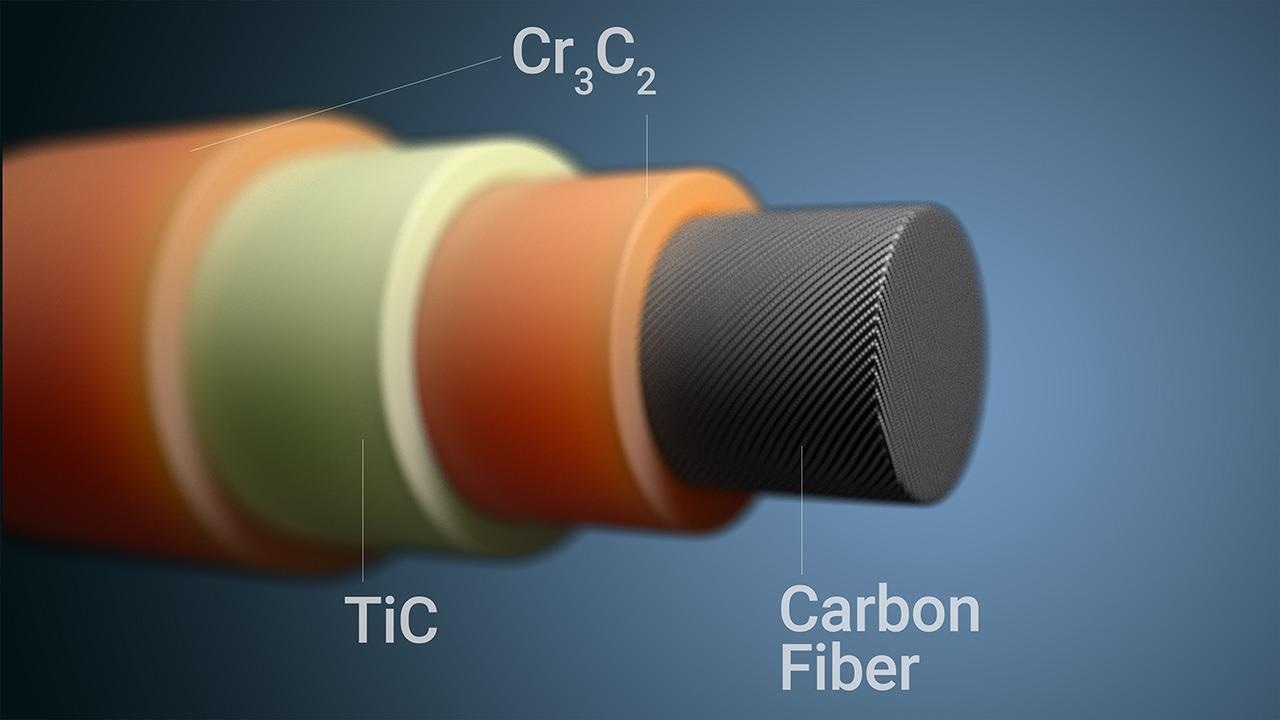Around five decades, manufacturers believed carbon fiber to be a dream material. Individual fibers are thinner than a strand of human hair, but they can be twisted together and fused with a matrix material to form a lightweight composite harder than steel, twice as stiff and exhibit good heat conductivity.
 Yongfeng Lu and colleagues have developed a simple, inexpensive method for guarding carbon fiber against oxidation. Dipping carbon fibers into a molten salt mixture containing titanium and chromium powders triggers a spontaneous reaction that leaves the fibers with a three-layer protective coating. The layers are made of chromium carbide and titanium carbide. Image Credit: University of Nebraska–Lincoln.
Yongfeng Lu and colleagues have developed a simple, inexpensive method for guarding carbon fiber against oxidation. Dipping carbon fibers into a molten salt mixture containing titanium and chromium powders triggers a spontaneous reaction that leaves the fibers with a three-layer protective coating. The layers are made of chromium carbide and titanium carbide. Image Credit: University of Nebraska–Lincoln.
When compared to metals, the carbon fiber does not crack over time. It is employed for various applications, including cars, air and spacecraft, medical devices, buildings and sports equipment.
However, according to Husker engineer Yongfeng Lu, an expert in carbon materials, carbon fiber features a significant drawback. When subjected to extreme temperatures — like those experienced often in the aerospace industry — carbon fiber oxidizes, which means it reacts with oxygen in the air and burns, similar to wood when it combines with enough heat and oxygen.
Oxidation rapidly reduces the dream-like qualities of carbon fiber, its strength in particular.
One weakness of carbon fibers is that they are burned easily if you have high enough temperatures and oxygen present. If we could make them non-flammable, so that they don’t burn when exposed to fire, that would be exciting.
Yongfeng Lu, Lott Distinguished Professor, Electrical and Computer Engineering, University of Nebraska–Lincoln
Lu and his associates explained a significant step towards their objective in their research published in the journal PNAS. Lu’s team from the University of Nebraska–Lincoln and the Institute of Condensed Matter Chemistry of Bordeaux in France created an inexpensive, scalable method for safeguarding carbon fiber against oxidation.
The technique portrays a significant improvement over other antioxidation processes that are expensive, laborious, and slow.
We are trying to add surface layers that can separate carbon fibers from oxygen so that even under high temperatures, they won’t be burned. Carbon fibers can be used in many ways — woven into textiles and in parts of buildings, airplanes, electronics equipment — but if they’re flammable, that poses a new risk to the system and limits those applications a lot.
Yongfeng Lu, Lott Distinguished Professor, Electrical and Computer Engineering, University of Nebraska–Lincoln
To annihilate, Lu and associates created a straightforward single-step process. The process begins by melting a salt that is chemically similar to table salt. Once the salt crystals become a liquid, the scientists introduced chromium and titanium powders, known to withstand high temperatures. Carbon fibers are later added to the mix.
Following a spontaneous reaction, the technique yields a three-layer coating — made of chromium carbide and titanium carbide — that acts as a barrier against oxidation. The coating is multilayered as titanium and chromium have varied behaviors and reaction rates within the molten salt, resulting in three distinct layers of the end product. This triple coating provides more protection than a single layer.
Upon evaluating the coated carbon fibers against extreme temperatures — about 2,200 °F — and extreme environmental conditions they simulated with an oxyacetylene flame, the researchers identified that the carbon material maintained its structure.
Lu stated that the further step is identifying just how fireproof the coated fibers are when compared to their unprotected counterparts, and how long they can retain their most valuable properties under extreme conditions.
Lu’s group is not the first to research methods for protecting carbon fibers against oxidation; however, if proven successful under additional testing, this method will be the first with large-scale viability. Earlier approaches, like chemical vapor deposition, involved multiple steps, costly equipment and chemical reactions that are tough to control.
The molten salt approach avoids these downsides by using cheap, basic, materials that undergo a spontaneous process at a relatively low temperature of about 1,800 °F.
The technique is also clean and quick, and therefore, can be geared for widespread industrial use.
We’ve found a recipe that can form three layers in a single state. With one single dip, we can get three layers of coating.
Yongfeng Lu, Lott Distinguished Professor, Electrical and Computer Engineering, University of Nebraska–Lincoln
The team included Loic Constantin, a graduate student at Nebraska’s Laser Assisted Nano Engineering Lab; Lisha Fan, a postdoctoral researcher in LANE; Bai Cui, associate professor of mechanical and materials engineering; and Jean-François Silvain, adjunct professor of electrical and computer engineering and research director of the Institute of Condensed Matter Chemistry of Bordeaux.
The research was supported by The National Science Foundation and Nebraska Research Initiative.
Journal Reference:
Constantin, L., et al. (2021) Spontaneous formation of multilayer refractory carbide coatings in a molten salt media. Proceedings of the National Academy of Sciences of the United States of America. doi.org/10.1073/pnas.2100663118.